Human Reproduction Questions And Answers
Question 1 . Draw a labelled diagram of the male reproductive system.
Answer:

Question 2. Draw a labelled diagram of the female reproductive system.
Answer:

Question 3. Write two major functions each of the testis and ovary.
Answer:
Functions of the Testis :
- They produce male gametes (sperm) by the process of called spermatogenesis.
- The ley dig cells of the seminiferous tubules secrete the male sex hormone called testosterone.
Functions of the ovary :
- They produce female gametes (ovum) by the process of oogenesis.
- The growing Graafian follicles secrete the female sex hormone called estrogen.
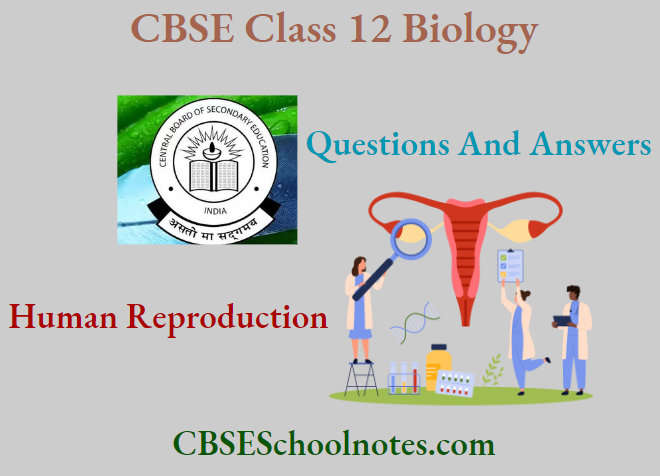
Question 4. Describe the structure of a seminiferous tubule. [IMP.]
Answer:
- A seminiferous tubule is made up of a layer of male germ cells and large Sertoli cells (nurse cells).
- The male germ cells undergo spermatogenesis to produce spermatocytes, spermatids and sperms.
- The regions outside the seminiferous tubules called interstitial spaces have connective tissue, which includes blood vessels and Leydig cells.
- Leydig cells synthesise and secrete the male sex hormones called androgens, of which testosterone is the principal one.

Question 5. What is spermatogenesis? Briefly describe the process of spermatogenesis.
Answer:
It is the process of formation of haploid sperms in seminiferous tubules of testes.
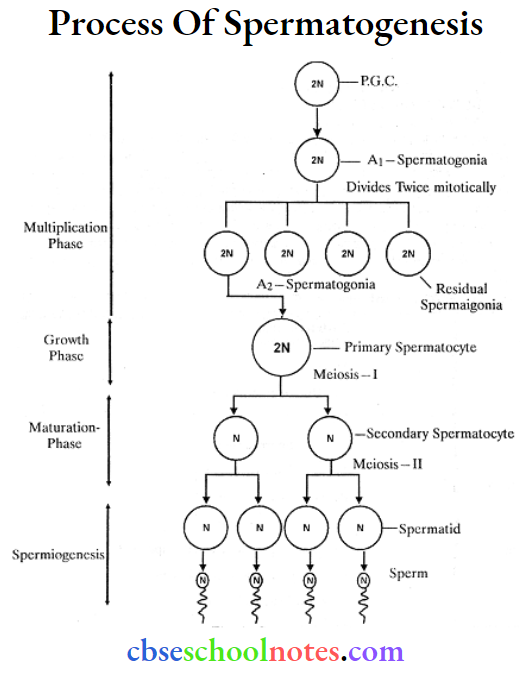
Question 6. Name the hormones involved in the regulation of spermatogenesis,
Answer:
GnRH (Gonadotropin releasing hormone), LH (Luteinising hormone), FSH (Follicle stimulating hormone), androgens.
Question 7. Define spermiogenesis and spermiation.
Answer:
- Spermiogenesis: The process of transformation of spermatids into spermatozoa in seminiferous tubules, is called spermiogenesis.
- Spermiation: After spermiogenesis, sperm heads become embedded in the Sertoli cells and are finally released from the seminiferous tubules by the process called spermiation.
Question 8. Draw a labelled diagram of sperm.
Answer:
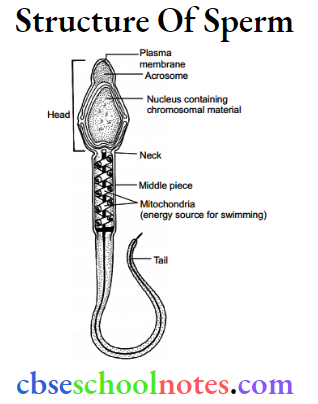
Question 9. What are the major components of seminal plasma?
Answer:
The major components of seminal plasma are :
- Secretions of the accessory sex glands of males – prostate gland, seminal vesicles, bulbourethral glands.
- Mainly composed of – calcium, fructose, and other enzymes
Question 10. What are the major functions of male accessory ducts and glands?
Answer:
The major functions of the male accessory ducts and glands are as follows:
Male accessory ducts
- Vasa efferentia: Conducts sperms from the rete testis to the epididymis.
- Rete testis: Stores sperms that are produced by seminiferous tubules.
- Epididymis: Physiological maturation of sperms, storage and nouri shipment.
- Vas deferens: Conducts sperms from epididymis to the urethra.
Male accessory glands
- Seminal vesicles: Activates and provides energy to facilitate sperm motility after ejaculation.
- Prostate gland: Nourishes and activates sperm, and enhances sperm motility.
- Cowper’s gland: It enhances the mobility & survival potentiality of sperms in the genital tract of the female reproductive system and neutralizes the activity of acidic female vaginal secretions.
Question 11. What is oogenesis? Give a brief account of oogenesis.
Answer:
Oogenesis is the phenomenon of the formation of haploid female gametes known as ova from diploid oogonia in the ovary is called as oogenesis. Oogenesis can be explained through the following flow chart.
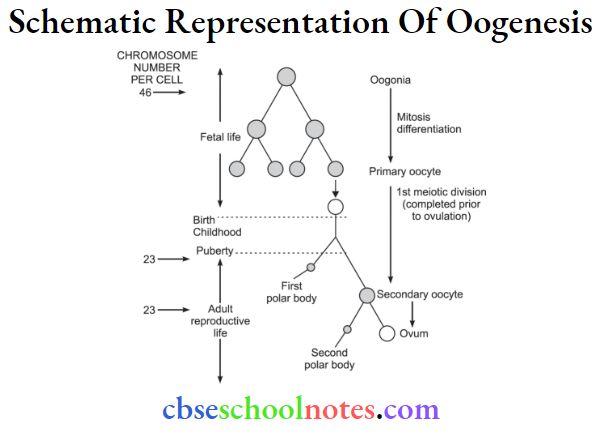
Question 12. Draw a labelled diagram of a section through the ovary.
Answer:
The diagram of a section of an ovary is as follows-

Question 13. Draw a labelled diagram of a Graafian follicle.
Answer:
The diagram of a Graafi follicle is as follows:
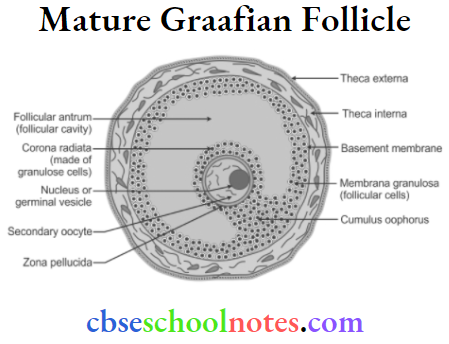
Question 14. Name the functions of the following :
- Corpus luteum
- Endometrium
- Acrosome
- Sperm tail
- Fimbria
Answer:
The functions of each are as follows :
- Corpus luteum – The corpus luteum secretes the hormone progesterone during the luteal phase of the menstrual cycle.
- Endometrium -The endometrium is the innermost layer of the uterus comprising glands that undergo cyclic changes during different stages of the menstrual cycle to prepare themselves for the embryo-implantation process.
- Acrosonie -It consists of the sperm lysin enzyme that helps in penetration of the outer membrane of the egg by sperm which facilitates the sperm to perforate through the egg during fertilization.
- Sperm tail – The sperm tail makes up for the longest part of the sperm, enabling the movement of the sperm, once it has entered the female reproductive tract.
- Fimbriae – Towards the ovarian end of the fallopian tube, finger-like projections emerge, these are the fimbriae which assist in the collection of the ovum after the ovulation.
Question 15. What is the menstrual cycle? Which hormones regulate the menstrual cycle?
Answer:
It is a reproductive cycle in female primates (e.g. monkeys, apes and human beings), in females menstruation is repeated at an average interval of about 28/29 days, the cycle of events starting from one menstruation till the next one is called the menstrual cycle.
The different hormones that regulate the menstrual cycle are LH – Luteinising hormone, FSH – follicle stimulating hormone, progesterone, and estrogen.
Question 16. What is parturition? Which hormones are involved in the induction of parturition?
Answer:
Parturition is the process wherein a fully developed foetus from the mother’s womb is expelled after the completion of the gestation period. The two critical hormones are involved in the induction of parturition are:
Oxytocin – It directs the full-term foetus towards the birth canal, as it causes the contraction of the smooth muscles of the myometrium of the uterus leading the baby to be expelled.
Relaxin – It relaxes the pelvic ligaments, widening the pelvis to assist in an easier childbirth.
Question 17. In our society, women are often blamed for giving birth to daughters. Can you explain why this is not correct?
Answer:
This is not correct to blame women for giving birth to daughters.
- The male sperm contain either X or Y chromosomes whereas the female egg contains only the X chromosome.
- At the time of fertilization, sperm with a Y chromosome combine with an egg-containing X chromosome which would be male.
- Thus scientifically sex of the baby is determined by the father and not by the mother as blamed in our society.
Question 18. How many eggs are released by a human ovary in a month? How many eggs do you think would have been released if the mother gave birth to identical twins? Would your answer change if the twins born were fraternal?
Answer:
Typically in a month, human ovaries release only one egg, rarely two. In the case of identical twins or monozygotic twins, one egg is released by the ovary which splits into two post fertilization. This is why identical twins exhibit the same genetic features.
On the other hand in fraternal twins or dizygotic twins, two eggs are released which are fertilized by two different sperms causing the fraternal twins to exhibit different genetic characteristics.
Question 19. How many eggs do you think were released by the ovary of a female dog which gave birth to 6 puppies?
Answer:
To have given birth to six puppies, the ovary of the female dog released six eggs. Hence, six zygotes were formed for each to develop into a puppy.
Human Reproduction Fill In The Blanks
Question 1. Humans reproduce______________(asexually/sexually)
Answer: Sexually
Question 2. Human are______________(oviparous, viviparous, ovoviviparous)
Answer: Viviparous
Question 3. Fertilization is human, (external/internal)______________
Answer: Internal
Question 4. Male and female gametes are (diploid/haploid)’______________
Answer: Haploid
Question 5. Zygote is______________(diploid/haploid).
Answer: Diploid
Question 6. The process of release of ovum from a mature follicle is called______________
Answer: Ovulation
Question 7. Ovulation is induced by a hormone called ______________
Answer: Luteinising hormone
Read and Learn More Class 12 Biology Chapter Wise
Question 8. The fusion of male and female gametes is called______________
Answer: Fertilization
Question 9. Fertilization takes place in______________
Answer: Ampulla of the oviduct
Question 10. The zygote divides to form______________which is implanted in the uterus.
Answer: Blastocyst
Question 11. The structure which provides a vascular connection between the foetus and the uterus is called______________
Answer: Placenta
Human Reproduction Identify True/False Statements
Identify True/False statements. Correct each false statement to make it true.
Question 1. Androgens are produced by Sertoli cells
Answer: False
Correct statement: Androgens are produced by the Ley dig cells.
Question 2. Spermatozoa get nutrition from Sertoli cells.
Answer: True
Question 3. Leydig cells are found in the ovary.
Answer: False
Correct statement: Leydig cells are found in the testis.
Question 4. Ley dig cells synthesise androgens.
Answer: True
Question 5. Oogenesis takes place in the corpus luteum.
Answer: False
Correct statement: Oogenesis takes place in the ovary.
Question 6. The menstrual cycle ceases during pregnancy.
Answer: True
Question 7. The presence or absence of hymen is not a reliable indicator of virginity or sexual experience.
Answer: True
